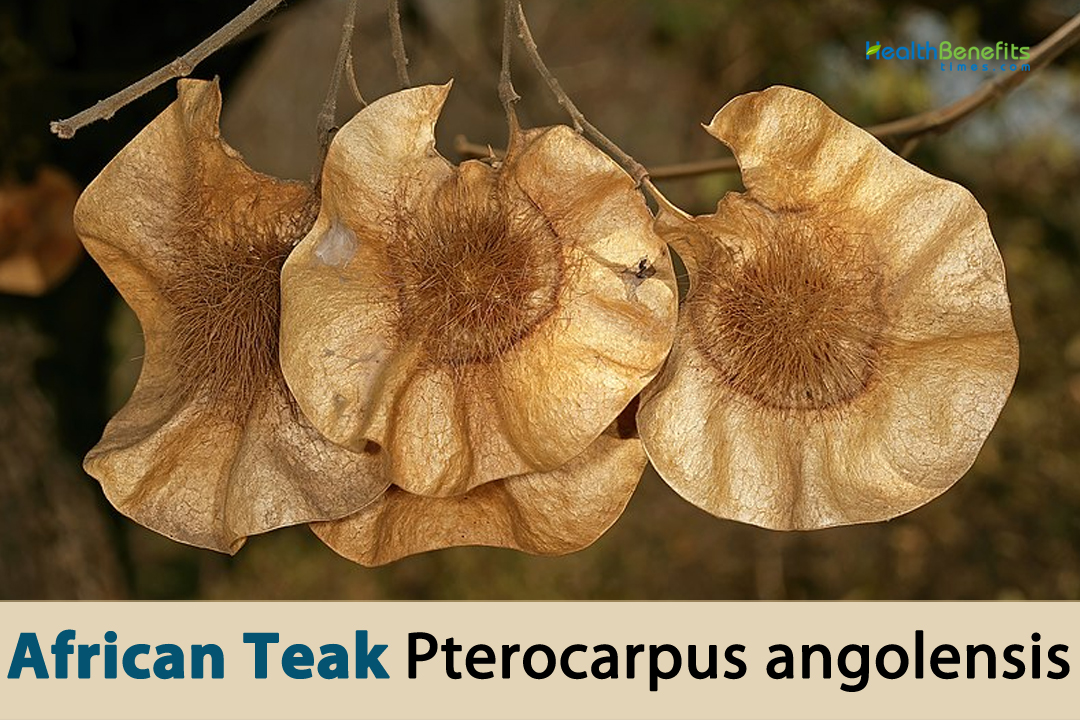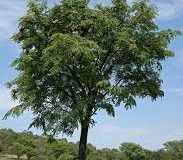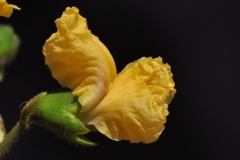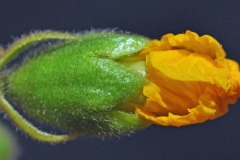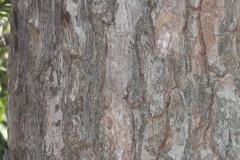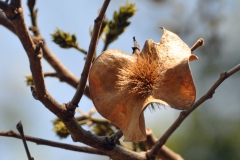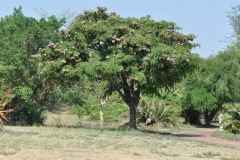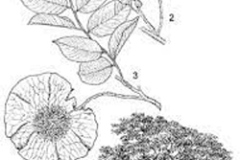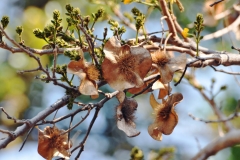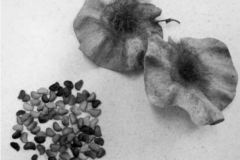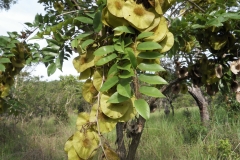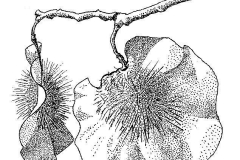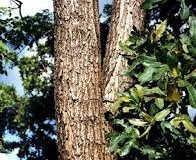The name “Pterocarpus” comes from the Greek words “ptero,” which means “wing,” and “karpos,” which means “fruit.” This name comes from the unique fruits that many species in the genus Pterocarpus have that have wings. Another name for “Angolensis” is “Angola,” which is a country in southwestern Africa. This name makes it sound like the tree is from Angola or has some connection to that country. People also often grow this plant as a decorative street tree or shade tree because of its many fragrant orange-yellow flowers. People want to cut down this tree because its wood is strong and looks good. Wood from this tree is used for many things, like building furniture, cabinets, floors, boats, veneer, and construction. Other things that it is used for are making singing instruments and carvings.
African Teak Facts
| African Teak Quick Facts | |
|---|---|
| Name: | African Teak |
| Scientific Name: | Pterocarpus angolensis |
| Origin | South Africa, Angola, Mozambique, Namibia, Eswatini, Tanzania, Democratic Republic of the Congo, Kenya, Botswana, Swaziland, Zimbabwe, and Zambia |
| Colors | Turns from green to yellow and after drying greyish |
| Shapes | Distinctive circular pod, covered in long bristles over the seed case |
| Taste | Slightly bitter taste, not for consumption |
| Health benefits | Wound Healing, Fever Reduction, Digestive Aid, Pain Relief, Respiratory Health, Liver Health, Anti-Aging Properties, Bone Health and Cardiovascular Health |
| Name | African Teak |
|---|---|
| Scientific Name | Pterocarpus angolensis |
| Native | South Africa, Angola, Mozambique, Namibia, Eswatini, Tanzania, Democratic Republic of the Congo, Kenya, Botswana, Swaziland, Zimbabwe, and Zambia |
| Common Names | African Teak, African Mahogany, Afzelia, Doussie, Red Mahogany, Papao, Chanfuta, Senegal Teak, Pod Mahogany, Apa, Lingue, Baku, Azobe, Mozambique Teak, Ghana Teak, Nigerian Afzelia, East African Mahogany, Senegalia Africana, Kambala, Katikati, Izombe, Akume, Bongossi, Linguee, Redwood Mahogany |
| Name in Other Languages | Afrikaans: Afrikaanse Teak, Rooikiaat, Kiaat, Greinhout, Bloedhoud Kehatenhout, Lakboom Amharic: Afdär (ዓፍደር), āfirīkani teketatayi (አፍሪካን ተከታታይ) Arabic: Tik Afriqi (تيك أفريقي), Afzaliya al-Afriqiya (عفزليا الأفريقية), tuz marjani (توز مرجاني) Bemba: Mulombwa Bengali: Āphrikāna ṭika (আফ্রিকান টিক) Bulgarian: Afrikanski Tik (Африкански Тик) Chichewa: Mvule Chichamorro: Okoume Chinese: Fēizhōu Yòumù (非洲柚木), Āngēlā zǐtán (安哥拉紫檀) Croatian: Afrički Tikovac Czech: Africký Teakovník Danish: Afrikansk Teak Dutch: Afrormosia, Afrikanees teak, Muninga, Transvaal teak English: African Teak, Afrormosia, Rhodesian Teak, Sealing-Wax Tree, Transvaal Teak, Wild Teak, Bleedwoodtree, Bloodwood, Kiaat, Muninga, Bloodwood Tree, Mukwa, Mbangozi, Mucambira, Mukula, Mulombe, Mulombwa, Umbila, Umvagazi, muninga Estonian: Aafrika Tiikpuu, Angoola tiibviljak Filipino: African Teak Finnish: Afrikan Teakpuu, Afrikanveripihkapuu, Umbila French: Afrormosia, Arbre à parfum, Bois afrormosia, Doussié africain German: Afrikanisches Teakholz, Afrormosia Greek: Afrikanikí Téka (Αφρικανική Τέκα) Gujarati: Āphrikana ṭīka (આફ્રિકન ટીક) Hausa: Bakin Marmara, Liman, Bokau, Mada Hindi: Afriki Tik (अफ्रीकी टीक) Hungarian: Afrikai Teak Fa Icelandic: Afrísk Teak Igbo: Obeche, Osisi Oji, Akume Irish: iorócó Italian: Afrormosia, Legno africano Japanese: Afurikantiiku (アフリカンティーク), Angorakarin (アンゴラカリン) Kannada: African Teak (ಆಫ್ರಿಕನ್ ಟೀಕ್) Kinyarwanda: Umuganda Korean: Apeurikan Tik (아프리칸 티크), kiateu (키아트) Latvian: Āfrikas Tīkkaoks Lingala: Nkula Lithuanian: Afrikinis Tika Medis Luganda: Mubambazi Malay: Tik Afrika Malayalam: Afrikkan thekku (ആഫ്രിക്കൻ തേക്ക്) Marathi: Āphrikana ṭīka (आफ्रिकन टीक) Ndebele: Umgangatho Norwegian: Afrikansk Teak Persian: تیک آفریقایی Polish: Drzewo Afrykańskie Tekowe Portuguese: Afrormosia, Pau africano, Doussie Africano, Umbila, muninga, umbila Punjabi: Āfarīkana ṭīka (ਆਫ਼ਰੀਕਨ ਟੀਕ) Romanian: Lemn African Teak Russian: Afrikanskii Tik (Африканский Тик) Senegal: Kus-kus Serbian: Afrički Tikovac (Афрички Тиковац) Shona: Mukwa wemvura weAfrica, Muputirikondo, Kiaat, Mubvamaropa, Mukwa, Mubvamakovo, Mubvinziropa, Mukambira, Mukonambiti, Mukurambira, Mukwa, Mukwirambira, Mushambaropa Slovak: Africký Tíkovník Slovenian: Afriški Tikovinec Somali: Geedka Afrika, Geed-Dabac Sotho: Moapane Spanish: Afrormosia, Armoisie Africana, Doussie Africano Swahili: Mti wa Teak wa Kiafrika, Mkongo wa Afrika, Mkongo, Mvule, Mninga Swazi: Emabondweni Swedish: Afrikansk Teak, Muningaträd Tamil: Āprikka tēkku (ஆப்ரிக்க தேக்கு) Telugu: Āphrikan ṭīk (ఆఫ్రికన్ టీక్) Thai: Mị̂ s̄ạk xæfrikā (ไม้สักแอฟริกา) Tigrinya: Afdär (ዓፍደር) Tsonga: Mpinga, Muvhangazi Tswana: Mokopane wa Afrika Turkish: Afrika Teak Ağacı Ukrainian: African Teak Wood (Африканське Текове Дерево) Vietnamese: Gỗ Teak Châu Phi West Africa: Huluna Wolof: Kokor Somba Xhosa: Umthi waseAfrika Yoruba: Iroko Oyinbo (African Teak), Oganwo, Apa Ijebu Zulu: Umthi we-Afrika, Umgangatho, Umsinsi we-Afrika, Indlandlovu, Ingozina, Umbilo, Umvangazi |
| Plant Growth Habit | Medium to large sized deciduous, spreading and slightly flat-crowned tree |
| Growing Climates | Wet and dry tropical forests, grassland, woodland, savanna woodland, bush veld, hillsides and wooded grassland |
| Soil | Adaptable to red loams and deep sandy soils, but not coastal sands or black clays |
| Plant Size | Tree reaches a height of 13 to 20 m. The bole is usually straight, from 3 to 8 m in length |
| Root | It is known that African Teak is naturally resistant to termites, which is a good quality for making wood |
| Stem | Base is straight and cylindrical, which makes it useful for woodworking and making timber |
| Bark | Bark on young twigs is smooth, grey and covered with hairs, and on the older branches and stems it is dark grey to brown and rough to longitudinally fissured |
| Leaf | Alternate, imparipinnate with 5-9 pairs of sub-opposite to alternate leaflets. Leaflets are elliptic lanceolate to obovate, 2.5 – 7 cm long, 2-4.5 cm wide. Leaflet margins are entire. It is dark green above, paler below, hairy when young; apex tapering to a bristle-like tip |
| Flowering season | December to February |
| Flower | Flowers in large, branched sprays, orange-yellow, appear before the leaves in panicles 10–20 cm long. These flowers are often pollinated by insects |
| Fruit Shape & Size | Fruit a very distinctive circular pod, covered in long bristles over the seed case and surrounded by a large membranous wing |
| Fruit Color | Turns from green to yellow and after drying greyish |
| Seed | Asymmetrical, 10-12 mm long, 7-8 mm wide and 4-5 mm thick; pointed at the micropylar end |
| Flavor/Aroma | Sweet and mildly fragrant scent |
| Taste | Slightly bitter taste, which is not intended for consumption |
| Plant Parts Used | Bark, leaves, Roots, Resin |
| Propagation | By seed, semi-hardwood or hardwood cuttings and root suckers |
| Lifespan | Up to 500 years or more |
| Season | January to April |
| Available Forms |
|
| Health benefits |
|
Plant Description
African Teak is a medium- to large-sized tree that loses its leaves in the fall. It has an open, rounded, or spreading trunk. The plant usually grows between 5 and 20 meters tall, but some have been seen growing up to 35 meters tall. The plant is sometimes only a bush that grows to be 5 meters tall. Trees that grow in full sun and good soil can live up to 100 years. By that time, they are at least 20 meters tall, with a crown diameter of 10 to 12 meters and a bole diameter of 50 to 60 cm. The plant grows in woods that are wet or dry, grasslands, woodlands, savanna woodlands, bush veld, hillsides, and grasslands that are mixed with trees. The plant likes grounds that are deep, loamy, and drain well. Some of the soil types it can grow in are sandy, loamy, and clayey. However, it does best in soils that have a lot of organic matter.
African Teak has been used as medicine for a long time to treat warts, stabbing pains, eye problems, malaria, black water fever, stomach problems, and to make more breast milk. People sometimes plant the tree around the chief’s enclosure to make a live wall. The inner bark is also used to make baskets. In many African countries, its wood is important to their culture and traditions. It has been used to make carvings, singing instruments, and everyday tools. In some native tribes, the tree is also important for spiritual and cultural reasons. As a result of its high resistance to decay, the wood can be used for many things, such as furniture, floors, cabinets, building boats, and construction.
Appropriate growing location of African Teak
African Teak is a hardwood tree native to various countries in southern Africa, including Angola, Zambia, and Namibia. When considering an appropriate growing location for African Teak, you should take into account its natural habitat and specific requirements:
- Climate: The area where African Teak grows best is warm and tropical to subtropical. It likes temps between 68°F and 30°C (20°C to 86°F), and it can’t stand frost.
- Rainfall: It does well in places where there is a clear wet season and a dry season. African Teak usually needs between 31 and 47 inches of rain a year, or 800 to 1,200 millimeters.
- Soil: It grows well in places with clear wet and dry seasons. Every year, African Teak needs about 31 to 47 inches of rain, which is 800 to 1,200 mm.
- Sunlight: African Teak loves the sun and does best when it’s out in the open. It doesn’t do well in deep shade.
- Altitude: This type of tree grows at elevations between sea level and about 1,200 meters (3,937 feet) above sea level.
- Water availability: African Teak can survive short-term droughts, but it grows best when it has easy access to water, especially when it is young.
- Pest and disease resistance: It is known that African Teak is naturally resistant to termites, which is a good quality for making wood.
Roots
Early on in its growth, African Teak usually grows a deep, strong taproot. The main, center root that goes up into the ground is called the taproot. It keeps the tree in place and makes it easier for it to get water and food from deeper in the ground, especially when it’s dry. Because it can grow to be several meters deep, the taproot is an important part of the tree’s structure. The secondary root system is made up of branch roots that grow out from the tree’s base. These roots spread out across the ground as they grow horizontally. Plants get nutrients and water from the top layers of dirt through their lateral roots. They usually stick together in a dense network that covers a large area. This keeps the tree stable and stops dirt from washing away.
There is a fibrous root system close to the soil’s top that comes from the stem roots. Root hairs are the small, thread-like roots that make up this system. Root hairs make a lot more surface area available for taking in water and nutrients. These are the main places where water and minerals move from the tree to the dirt. Under certain situations, like in swampy or wet places, it may grow special aerial roots known as pneumatophores. From the underground parts of the root system, these roots grow straight up and come out above the water or wet dirt. These are very important because they help the tree’s underground tissues share oxygen with the air and also support the tree’s structure when it’s wet.
Stem
The main stem, which is also called the trunk, is the straight part in the middle of the tree. In addition to supporting the tree’s branches and leaves, it’s the main way that water, nutrients, and products from photosynthesis get from the base to the top of the tree. People like it because its base is straight and cylindrical, which makes it useful for woodworking and making timber. The woody xylem is at the very center of the stem. It is made up of different kinds of cells, like fibers and vessels that carry water and minerals from the base to the leaves. Additionally, xylem cells help the stem stay stable. Xylem is known for being strong, long-lasting, and having a unique color that can range from light brown to dark brown.
Bark
The bark’s top layer is made up of dead cells that are constantly being shed and renewed. This layer on the outside of African Teak is usually rough and dark brown or greyish brown. It keeps your property safe from damage caused by things like weather, animals, and insects. A layer of cork with cork cells is just below the bark on the outside. These cells don’t let water out and add another layer of defense against pathogens, pests, and water loss. Through transpiration, the cork shell helps keep water in the plant.
It is a thin layer of live cells that lies below the cork layer. These cells are in charge of making new cork cells to replace the ones that are constantly being shed from the outer bark. The cork cambium, which is also called the phellogen, is a layer of cells that are constantly dividing. It makes new cork cells on the outside and new phelloderm cells on the inside. This layer makes room for the cork layer to grow.
Leaves
The leaves on African Teak trees are usually very simple and are arranged in a design of one leaf on top of another along the branches. This means that each leaf is not attached to the stem across from the other leaves. Instead, each leaf is attached at a different place. The leaves are pinnately compound, which means they have many leaflets that are arranged in a feather-like design along a central stalk known as the rachis. Long and lance-shaped, each leaflet has a pointy tip and jagged edges. The leaves can be up to 10 to 15 centimetres long and 2 to 3 centimetres wide. Leaves can be different colors based on how old they are and what’s around them. Leaves that are young are usually a brown or bronze color. Leaves that are fully grown are usually dark green on top and lighter green below.
Most of the time, the leaves are smooth and rubbery. The top surface is shiny, which helps keep water from evaporating. There is a clear network of veins on the leaves. The veins are raised on the top and more flattened on the bottom. The design of veins in this leaf helps move water and nutrients around the leaf. The rachis and each leaflet are joined by a short stalk known as a petiolule. The rachis then connects to the tree’s branch or stem. The tips of the leaflets are pointy, and they get less pointy as they get closer to the base, where they connect to the rachis. The leaves can be different sizes, but most of the time they are medium-sized and provide a good amount of shade around the tree.
Flower
Flowers on African Teak trees grow in inflorescences, which are groups or clumps of flowers. The tips of the trees are where you can find these flower arrangements. Each flower is small and doesn’t stand out much. The width of most of them is between 3 and 5 millimeters. The flowers usually look like tubes or funnels, with a long, thin tube that opens up into a bloom that flares out. This form works well for the way they pollinate. Each flower is a different color, but most of the time they are creamy white to pale yellow.
The corolla of an African Teak flower is shaped like a funnel and is made up of five petals that are joined together. When the flower is fully open, these petals are often set up in a way that looks like stars. The male parts of the flower are called stamens, and there are usually five of them connected to the inside of the corolla tube. A thin stalk and an anther, which makes pollen, make up each stamen. The pistil is the name for the female sexual part of the flower. It has a stigma, a style, and an ovary and is in the middle of the flower. For fertilization to work, the stigma is where the pollen needs to land. Bugs, like bees and butterflies, are the main species that fertilize African Teak trees. These pollinators are drawn to the flowers because they are tubular and a creamy white to pale yellow color. When insects visit flowers to find food, they move pollen from the anthers to the stigma without meaning to.
Fruits
The fruit is a dry shell that opens up. “Dehiscent” means that the fruit automatically splits open to release its seeds when it’s ready. The cells are pretty small, measuring only 1 to 2 centimetres in length. They have a long, cylinder-shaped shape. The shells are rough and hard, which helps keep the seeds inside safe. After being fully grown, the pods can be any color from light brown to dark brown or even greyish brown. There is a special way for the fruit shells to open and let the seeds out. When they are fully grown, they usually split open along several horizontal lines, or seams. This splitting apart lets the seeds leave the parent tree and grow on other trees.
Seeds
The seeds of the African Teak tree are small, flat, and oval or circular in shape. The length of most of them is between 1 and 2 centimetres. Seeds can be any color, but most of the time they are brown or dark brown to fit in with the soil. One thing that makes seeds unique is that they have a structure on them that looks like wings. This wing goes along one side of the seed and is made of paper. The wing is a trait that helps the wind spread seeds.
The seed coat, which is also called the seed’s top covering, is tough and hard. Outside factors can’t get to the embryo and endosperm inside the seed because of this protected layer. The embryo is the plant that is still growing inside the seed. It has the genetic information and structures that the plant needs to become a tree when the circumstances are right. In African Teak, the seed coat works well to protect the egg. Between 3,400 and 5,000 seeds are in a kg.
Health benefits of African Teak
African Teak is a tree native to southern Africa. While it is primarily known for its high-quality timber, there are some traditional uses of this tree in indigenous medicine. It’s important to note that the health benefits are based on traditional knowledge and may not be supported by extensive scientific research. Here are some traditional health benefits attributed to African Teak
1. Anti-Inflammatory Properties
People think that the bark and oil of the African Teak tree can help reduce inflammation. People with inflammatory diseases, like arthritis and joint pain, have used them to feel better.
2. Wound Healing
As part of some traditional medicine methods, wounds are treated with tree sap or resin. Due to its possible antimicrobial qualities, it is thought to help wounds heal and stop infections.
3. Fever Reduction
In traditional medicine, teas or other drinks made from parts of the tree, like the bark, have been used to lower fevers and treat malaria.
4. Digestive Aid
In some countries, African Teak has been used to ease stomach problems. People who have stomachaches or trouble digesting can drink infusions of the bark to help.
5. Anti-Malarial Properties
Several studies have shown that some compounds in African Teak may be able to kill malaria parasites. This could help avoid and treat malaria. But more scientific research is needed to be sure of these benefits.
6. Anti-Microbial Effects
Researchers have looked into extracts from the tree to see if they might have antimicrobial qualities. Some germs and fungi may not be able to grow on them, which could affect how well infections are treated.
7. Antioxidant Activity
African Teak has chemicals in it that work as antioxidants. Antioxidants may be good for your health in general and help protect cells from damage caused by free radicals.
8. Anti-Diabetic Properties
Some studies show that products from African Teak may help people who have diabetes. People with diabetes might benefit from it because it is thought to help control blood sugar levels. But more study is needed to be sure of these effects.
9. Anti-Cancer Potential
Initial study suggests that some compounds in African Teak may be able to fight cancer. These chemicals might help stop the growth of cancer cells. But more research needs to be done to fully understand how it works and what it could be used for in cancer care.
10. Pain Relief
For a long time, African Teak has been used to treat pain naturally. It can be used to ease different kinds of pain, like muscle pain, headaches, and menstrual cramps.
11. Respiratory Health
African Teak has been used to help people with breathing problems in some places. People think it can help ease the signs of lung diseases like coughs and bronchitis.
12. Liver Health
African Teak has been used for a long time to help the liver. It might be used to clean out the liver and make it work better, but more study is needed to prove these claims.
13. Anti-Aging Properties
Because it has antioxidants, African Teak can be used in traditional beauty and skin care products. Antioxidants can help keep your skin looking young by stopping it from aging too quickly.
14. Bone Health
Some types of traditional medicine say that African Teak may be good for your bones. It can be used to make bones stronger and increase their total density.
Not much study has been done on the possible heart health benefits of African Teak. More study is needed to say for sure if it helps keep blood pressure in a healthy range and lowers the risk of heart problems.
Different uses of African Teak
African Teak is a versatile and valuable wood known for its strength, durability, and attractive appearance. It has a wide range of uses in various industries and applications. Here are different uses of African Teak:
- Furniture: People pay a lot of money for furniture made from African Teak. It is often used to make tables, chairs, cabinets, and other fine wooden furniture because it is naturally beautiful, doesn’t rot, and lasts a long time.
- Flooring: A lot of people choose flooring made of teakwood from Africa. Because it is hard and doesn’t wear down easily, it’s perfect for places that get a lot of use in homes and businesses.
- Decking: Because it naturally doesn’t get damaged by water or bugs, African Teak is often used for outdoor decks. It can handle the weather well and doesn’t need much upkeep.
- Boat Building: People know that teak is good for building boats. It’s very valuable because it can stand up to the sea and bad weather, which makes it a great choice for boat decks and trim.
- Interior Paneling: African Teak is often used for internal paneling in homes, offices, and high-end businesses because of its rich color and grain.
- Cabinetry: Teakwood is often used for kitchen and bathroom cabinets because it lasts a long time and doesn’t get damaged by water.
- Garden Furniture: Many kitchen and bathroom drawers are made of teakwood because it lasts a long time and doesn’t rot when it gets wet.
- Musical Instruments: Because it sounds good, African Teak is sometimes used to make musical instruments like acoustic guitars, especially for the backs and sides.
- Construction: Sometimes, structural parts like beams, posts, and columns are made out of teak wood. It is also used to make building details that look nice.
- Carving and Sculptures: Because African Teak has a fine grain and is easy to work with; it can be carved and sculpted to make detailed and beautiful pieces.
- Marine Applications: Due to its resistance to water and decay, teak is used in the marine industry for more than just making boats. It is used for hatches, handrails, and cabinets.
- Woodworking Tools: Because it is hard and stable, teak is used to make high-quality woodworker tools like plane soles and handles.
- Oil Extraction: In some places, Teak seeds are used to get oil, which has been used for centuries to treat illnesses and make skin look better.
- Energy Production: In places where it’s easy to find, teak wood is sometimes used as fuel for cooking and heating.
- Outdoor Structures: Because it doesn’t rot or get damaged easily, African Teak is often used to build outdoor buildings like pergolas, gazebos, and pavilions.
- Woodworking Crafts: African Teak is often used by craftsmen and artists to make intricate wooden items like art pieces, cutting boards, and decorative boxes.
- Architectural Millwork: Architectural millwork, such as molding, trim, and decorative features, are made from teak wood to make buildings and their interiors look better.
- Handrails and Balustrades: African Teak can be used for stairs and balustrades in homes, businesses, and public buildings because it is strong and lasts a long time.
- Durable Outdoor Play Equipment: Teak is sometimes used to make outdoor play equipment for kids that is strong and lasts a long time, like swings, slides, and climbing frames.
- Sculpture Bases: African Teak is used as bases and pedestals for statues because it is stable and doesn’t react badly to the environment. It makes a strong and attractive support structure.
- Luxury Woodworking: Luxury high-end woodworkers often use African Teak for making one-of-a-kind furniture and home decor because of its beautiful color and unique grain patterns.
- Landscape Timbers: Luxury high-end woodworkers often use African Teak for making one-of-a-kind furniture and home decor because of its beautiful color and unique grain patterns.
- Instrument Cases: Teak is also used to make cases that are strong and safe for fragile tools like cameras and scientific equipment, as well as musical instruments.
- Religious and Cultural Artifacts: African Teak can be used to make religious and cultural items like shrines, religious icons, and objects used in ceremonies.
- Sustainability Initiatives: In some places, African Teak is planted and cared for as part of attempts to promote sustainable wood production through reforestation and afforestation.
- Park Benches: Teakwood is often used for park seats and public seating because it lasts a long time and doesn’t rot.
- Boat Accessories: Besides being used to build boats, teak is also used to make things like swim platforms, handles, and trim for boats.
- Home Decor: Teakwood can be used to make many home art items, such as picture frames, mirror frames, and wall panels that look nice.
- Antique Restoration: Teak from Africa is sometimes used to fix up old furniture and building parts, which helps keep historical items alive.
Side effects of African Teak
African Teak is primarily known for its use in woodworking and construction, and it is not commonly associated with side effects when used for these purposes. However, there are some considerations to keep in mind:
- Dust and Allergies: It is possible to breathe in wood dust when working with African Teak wood, especially when cutting, cleaning, or finishing. For some people, breathing in wood dust can make their lungs hurt and cause allergies. Whenever you work with any kind of wood, you should make sure you have the right breathing protection and dust control tools.
- Skin Irritation: For people who are sensitive, coming into direct touch with the wood or sawdust can irritate the skin or cause allergic reactions. Putting on safety gear like gloves can help lower this risk.
- Chemical Sensitivity: The natural oils and resins in African Teak wood may be too strong for some people. In some cases, these substances can cause rashes or dermatitis on the face.
- Eye Irritation: Woodworking with African Teak can make wood chips that can be irritating to the eyes. When dealing with this wood, it’s best to wear safety glasses.
- Potential Toxin Release: In very rare cases, some types of wood may give off chemicals that are harmful or cause allergies. Even though African Teak isn’t usually known for this, it is best to work in well-ventilated places to avoid being too close to any possible emissions.
References:
https://npgsweb.ars-grin.gov/gringlobal/taxon/taxonomydetail?id=30283
https://www.cabidigitallibrary.org/doi/10.1079/cabicompendium.45414
http://www.theplantlist.org/tpl1.1/record/ild-1884
https://tropical.theferns.info/viewtropical.php?id=Pterocarpus+angolensis
https://apps.worldagroforestry.org/treedb/AFTPDFS/Pterocarpus_angolensis.PDF
https://pfaf.org/user/Plant.aspx?LatinName=Pterocarpus+angolensis
https://en.wikipedia.org/wiki/Pterocarpus_angolensis


